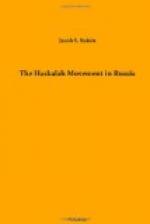Busily ’gan for the souls to pray
On them that gave him wherewith to scolay.
For a faithful and vivid description of the yeshibot we cannot do better than transcribe the account given in the pages of the little pamphlet Yeven Mezulah in which Nathan Hannover, mentioned above, has left us a reliable history of the Cossack uprisings and the Kulturgeschichte of his own time.
I need bring no proof for the statement that nowhere was the study of the Law so universal as in Russo-Poland. In every community there was a well-paid dean (rosh yeshibah), who, exempt from worry about a livelihood, devoted himself exclusively to teaching and studying by day and by night. In every kahal, many youths, maintained liberally, studied under the guidance of the dean. In turn, they instructed the less advanced, who were also supported by the community. A kahal of fifty [families] had to provide for at least thirty such. They boarded and lodged in the homes of their patrons, and frequently received pocket-money in addition. Thus there was hardly a house in which the Torah was not studied, either by the master of the house, a son, a son-in-law, or a student stranger. They always bore in mind the dictum of Rabba, “He who loves scholars will have scholarly sons; he who welcomes scholars will have scholarly sons-in-law; he who admires scholars will become learned himself.” No wonder, then, that every community swarmed with scholars, that out of every fifty of its members at least twenty were far advanced, and had the morenu (i.e. bachelor) degree.
The dean was vested with absolute authority. He could punish an offender, whether rich or poor. Everybody respected him, and he often received gifts of money or valuables. In all religious processions he came first. Then followed the students, then the learned, and the rest of the congregation brought up the rear. This veneration for the dean prompted many a youth to imitate his example, and thus our country was rendered full of the knowledge of the Law.
What became of the students when they were graduated? Let us turn once more to Hannover’s interesting narrative. The “fairs” of those days were much more than opportunities for barter; they afforded favorable and attractive occasions for other objects. Zaslav and Yaroslav during the summer, Lemberg and Lublin in the winter, were “filled with hundreds of deans and thousands of students,” and one who had a marriageable daughter had but to resort thither to have his worries allayed. Therefore, “Jews and Jewesses attended these bazaars in magnificent attire, and [each season] several hundred, sometimes as many as a thousand, alliances were consummated.”




